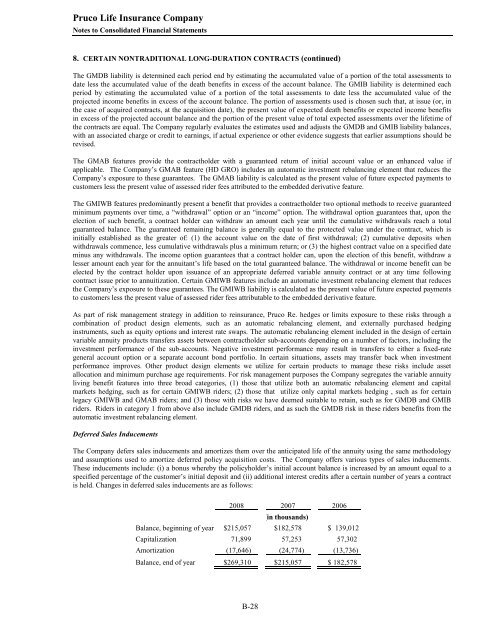The Prudential Series Fund
The Prudential Series Fund
The Prudential Series Fund
Create successful ePaper yourself
Turn your PDF publications into a flip-book with our unique Google optimized e-Paper software.
Pruco Life Insurance Company<br />
Notes to Consolidated Financial Statements<br />
8. CERTAIN NONTRADITIONAL LONG-DURATION CONTRACTS (continued)<br />
<strong>The</strong> GMDB liability is determined each period end by estimating the accumulated value of a portion of the total assessments to<br />
date less the accumulated value of the death benefits in excess of the account balance. <strong>The</strong> GMIB liability is determined each<br />
period by estimating the accumulated value of a portion of the total assessments to date less the accumulated value of the<br />
projected income benefits in excess of the account balance. <strong>The</strong> portion of assessments used is chosen such that, at issue (or, in<br />
the case of acquired contracts, at the acquisition date), the present value of expected death benefits or expected income benefits<br />
in excess of the projected account balance and the portion of the present value of total expected assessments over the lifetime of<br />
the contracts are equal. <strong>The</strong> Company regularly evaluates the estimates used and adjusts the GMDB and GMIB liability balances,<br />
with an associated charge or credit to earnings, if actual experience or other evidence suggests that earlier assumptions should be<br />
revised.<br />
<strong>The</strong> GMAB features provide the contractholder with a guaranteed return of initial account value or an enhanced value if<br />
applicable. <strong>The</strong> Company’s GMAB feature (HD GRO) includes an automatic investment rebalancing element that reduces the<br />
Company’s exposure to these guarantees. <strong>The</strong> GMAB liability is calculated as the present value of future expected payments to<br />
customers less the present value of assessed rider fees attributed to the embedded derivative feature.<br />
<strong>The</strong> GMIWB features predominantly present a benefit that provides a contractholder two optional methods to receive guaranteed<br />
minimum payments over time, a ―withdrawal‖ option or an ―income‖ option. <strong>The</strong> withdrawal option guarantees that, upon the<br />
election of such benefit, a contract holder can withdraw an amount each year until the cumulative withdrawals reach a total<br />
guaranteed balance. <strong>The</strong> guaranteed remaining balance is generally equal to the protected value under the contract, which is<br />
initially established as the greater of: (1) the account value on the date of first withdrawal; (2) cumulative deposits when<br />
withdrawals commence, less cumulative withdrawals plus a minimum return; or (3) the highest contract value on a specified date<br />
minus any withdrawals. <strong>The</strong> income option guarantees that a contract holder can, upon the election of this benefit, withdraw a<br />
lesser amount each year for the annuitant’s life based on the total guaranteed balance. <strong>The</strong> withdrawal or income benefit can be<br />
elected by the contract holder upon issuance of an appropriate deferred variable annuity contract or at any time following<br />
contract issue prior to annuitization. Certain GMIWB features include an automatic investment rebalancing element that reduces<br />
the Company’s exposure to these guarantees. <strong>The</strong> GMIWB liability is calculated as the present value of future expected payments<br />
to customers less the present value of assessed rider fees attributable to the embedded derivative feature.<br />
As part of risk management strategy in addition to reinsurance, Pruco Re. hedges or limits exposure to these risks through a<br />
combination of product design elements, such as an automatic rebalancing element, and externally purchased hedging<br />
instruments, such as equity options and interest rate swaps. <strong>The</strong> automatic rebalancing element included in the design of certain<br />
variable annuity products transfers assets between contractholder sub-accounts depending on a number of factors, including the<br />
investment performance of the sub-accounts. Negative investment performance may result in transfers to either a fixed-rate<br />
general account option or a separate account bond portfolio. In certain situations, assets may transfer back when investment<br />
performance improves. Other product design elements we utilize for certain products to manage these risks include asset<br />
allocation and minimum purchase age requirements. For risk management purposes the Company segregates the variable annuity<br />
living benefit features into three broad categories, (1) those that utilize both an automatic rebalancing element and capital<br />
markets hedging, such as for certain GMIWB riders; (2) those that utilize only capital markets hedging , such as for certain<br />
legacy GMIWB and GMAB riders; and (3) those with risks we have deemed suitable to retain, such as for GMDB and GMIB<br />
riders. Riders in category 1 from above also include GMDB riders, and as such the GMDB risk in these riders benefits from the<br />
automatic investment rebalancing element.<br />
Deferred Sales Inducements<br />
<strong>The</strong> Company defers sales inducements and amortizes them over the anticipated life of the annuity using the same methodology<br />
and assumptions used to amortize deferred policy acquisition costs. <strong>The</strong> Company offers various types of sales inducements.<br />
<strong>The</strong>se inducements include: (i) a bonus whereby the policyholder’s initial account balance is increased by an amount equal to a<br />
specified percentage of the customer’s initial deposit and (ii) additional interest credits after a certain number of years a contract<br />
is held. Changes in deferred sales inducements are as follows:<br />
2008 2007 2006<br />
((in thousands)<br />
Balance, beginning of year $215,057 $182,578 $ 139,012<br />
Capitalization 71,899 57,253 57,302<br />
Amortization (17,646) (24,774) (13,736)<br />
Balance, end of year $269,310 $215,057 $ 182,578<br />
B-28
















